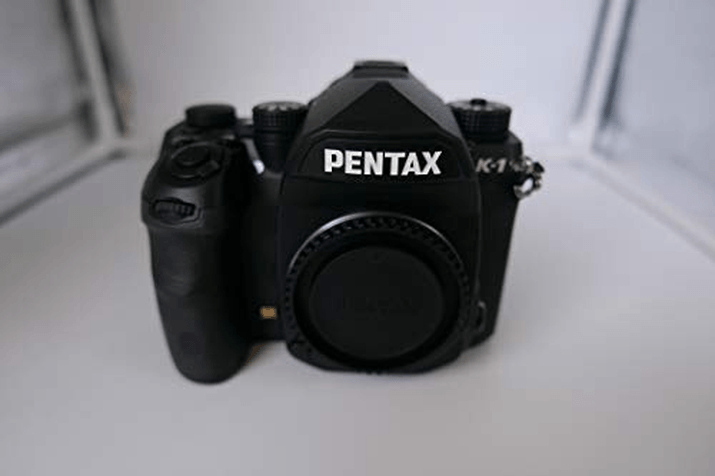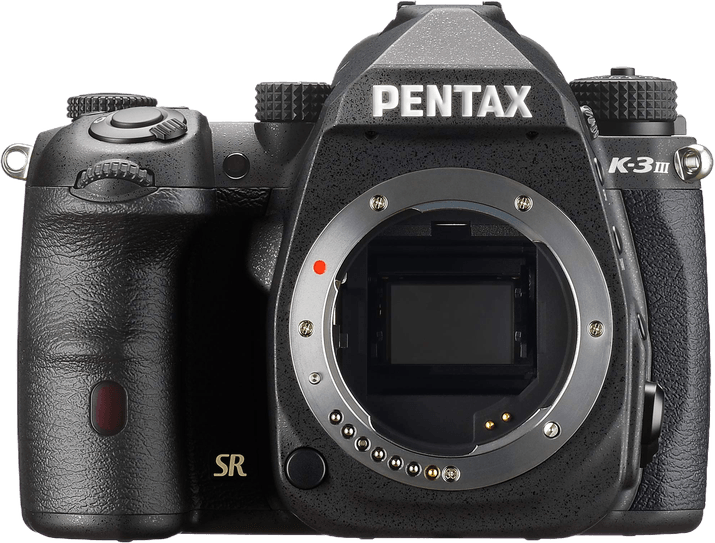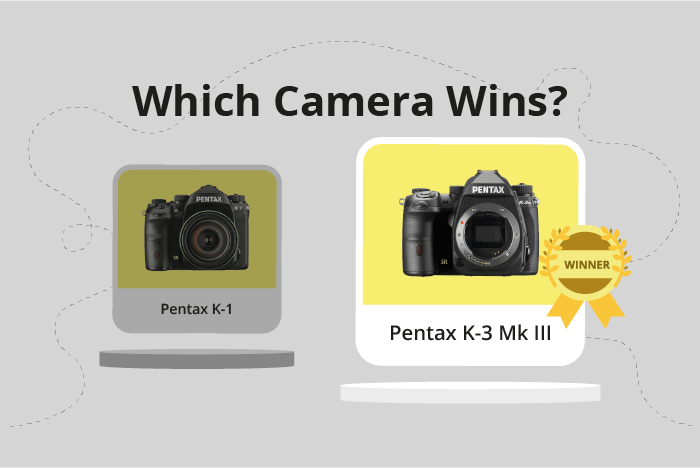Pentax K-1 vs K-3 Mark III Comparison
Pentax K-1

Pentax K-3 Mark III

The Pentax K-3 Mark III outperforms the Pentax K-1 with a score of 83/100 compared to 77/100. Both cameras are DSLR models, with the K-1 being released in 2016 and the K-3 Mark III in 2021. They share similar dimensions, with the K-1 measuring 137 x 110 x 86mm and the K-3 Mark III at 135 x 104 x 74mm.
The K-3 Mark III stands out due to its higher score, reflecting its superior performance. Additionally, it is lighter, weighing 820g compared to the K-1’s 1010g, making it more portable and comfortable to use. However, the K-1 has a lower launch price of $1800, compared to the K-3 Mark III’s $1999, which might make it more appealing to budget-conscious buyers.
After considering each camera’s specifications, it is clear that the Pentax K-3 Mark III offers better performance and portability, while the Pentax K-1 provides a more affordable option.
Pentax K-1 vs K-3 Mark III Overview and Optics
The Pentax K-1 emerges as the winner in the optics comparison with a score of 85/100, while the Pentax K-3 Mark III scores 82/100. Both cameras share several specifications, such as the CMOS sensor type, Prime IV processor, Pentax KAF lens mount, and image stabilization. Additionally, both cameras have the same DXOMARK score of 96 for their sensors.
The Pentax K-1 boasts a higher megapixel count of 36.4 compared to the K-3 Mark III’s 26 megapixels. This difference allows the K-1 to capture more detailed and sharper images. Furthermore, the K-1 has a full-frame sensor, which provides better low-light performance and a shallower depth of field, enhancing image quality and creative potential.
On the other hand, the Pentax K-3 Mark III has a faster shooting speed of 12 frames per second, compared to the K-1’s 4.4 frames per second. This advantage makes the K-3 Mark III more suitable for capturing fast-moving subjects or action photography. However, the K-3 Mark III has an APS-C sensor, which is smaller than the K-1’s full-frame sensor, resulting in a crop factor that affects the field of view.
In terms of optics, the Pentax K-1 performs better due to its higher megapixel count and full-frame sensor, providing superior image quality and low-light performance. The Pentax K-3 Mark III, although not as strong in image quality, excels in capturing fast-moving subjects with its higher shooting speed. Ultimately, the choice between these two cameras depends on the specific needs and preferences of the photographer.
Pentax K-1 vs K-3 Mark III Video Performance
The Pentax K-3 Mark III outperforms the Pentax K-1 in video capabilities with a score of 83/100, a 13-point difference compared to the K-1’s score of 70/100. Both cameras share some common specifications, such as a maximum video frame rate of 60fps and built-in time-lapse functionality. However, the K-3 Mark III surpasses the K-1 in terms of video resolution and dimensions.
The K-3 Mark III’s superior video quality is evident in its 4K maximum video resolution and 3840 x 2160 video dimensions. This higher resolution enables users to capture more detailed and sharper footage, resulting in professional-grade video content. In contrast, the K-1 offers a maximum video resolution of Full HD and video dimensions of 1920 x 1080, which, while still providing high-quality footage, is not as impressive as the 4K capabilities of the K-3 Mark III.
The K-1’s video capabilities are not completely overshadowed by the K-3 Mark III, as both cameras offer the same maximum video frame rate and time-lapse functionality. These features ensure smooth video playback and creative options for users of both models. However, the K-1’s lower video resolution and dimensions make it less suitable for those seeking the highest possible video quality.
Considering the differences in video capabilities, the Pentax K-3 Mark III emerges as the superior option for videographers and content creators, thanks to its 4K resolution and larger video dimensions. While the Pentax K-1 maintains some competitive features, such as the 60fps frame rate and time-lapse functionality, its Full HD resolution falls short of the K-3 Mark III’s performance.
Pentax K-1 vs K-3 Mark III Features and Benefits
The Pentax K-3 Mark III wins the feature comparison with a score of 87/100, while the Pentax K-1 scores 59/100. Both cameras share some specifications, such as a 3.2-inch screen size and WIFI connectivity. However, the K-3 Mark III outperforms the K-1 in several aspects, making it the superior choice in terms of features.
The K-3 Mark III has a higher screen resolution of 1,620,000 dots compared to the K-1’s 1,037,000 dots. This results in crisper and clearer image previews. Additionally, the K-3 Mark III comes with a touchscreen, allowing users to navigate menus and review images with ease. The K-3 Mark III also offers Bluetooth connectivity, enabling seamless transfer of images to smartphones or other compatible devices.
On the other hand, the K-1 has a flip screen, which is absent in the K-3 Mark III. This feature allows users to shoot from various angles with ease, making it beneficial for photographers who often capture images from unconventional perspectives. Moreover, the K-1 is equipped with GPS functionality, which is useful for geotagging photographs and tracking shooting locations.
To conclude, the Pentax K-3 Mark III’s superior screen resolution, touchscreen, and Bluetooth connectivity make it the better choice in terms of features. However, the Pentax K-1 still holds value with its flip screen and GPS capabilities. Ultimately, the choice between these two cameras depends on the individual photographer’s needs and preferences.
Pentax K-1 vs K-3 Mark III Storage and Battery
The Pentax K-3 Mark III takes the lead in storage and battery with a score of 81/100, compared to the Pentax K-1’s score of 68/100. Both cameras share some common specifications, such as having two memory card slots and accepting SD, SDHC, and SDXC memory cards. They also use the same D-LI90 battery type.
The K-3 Mark III outperforms the K-1 in battery life, offering 800 shots per charge, while the K-1 provides 760 shots. Additionally, the K-3 Mark III has a significant advantage with USB charging capability, which the K-1 lacks. This feature allows for more convenient charging options.
The K-1 has one minor advantage, as both of its memory card slots are UHS-I compatible, while only one of the K-3 Mark III’s slots supports UHS-II. However, this difference is not significant enough to outweigh the benefits of the K-3 Mark III’s longer battery life and USB charging.
Considering these factors, the Pentax K-3 Mark III proves to be the superior choice in terms of storage and battery capabilities, making it a more practical and versatile option for photographers.
Pentax K-1 vs K-3 Mark III – Our Verdict
Are you still undecided about which camera is right for you? Have a look at these popular comparisons that feature the Pentax K-1 or the Pentax K-3 Mark III:

